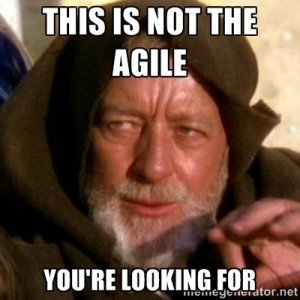The New Agile–The beginning
 Frequent readers of this blog know I’m a big proponent of agile, with a small ”a”. I tend to scoff at new big ideas that seem to jump out of a marketing committee.
Frequent readers of this blog know I’m a big proponent of agile, with a small ”a”. I tend to scoff at new big ideas that seem to jump out of a marketing committee.
Truth is, sometimes these are good ideas. Sometimes they are first versions of trials and errors. When we look at them at the current stage they may seem ridiculous, but if someone get exposed to them, and continues the push, we may get something wonderful. Much like quality, we get the real judgment after the fact, sometimes years later.
Therefore, I’ve decided to put some of my cynicism aside, and try to look at things in the agile world that have happened since the agile manifesto – critically. The collection of the posts called “The New Agile” stood behind the making of my “The New Agile” presentation. I presented different topics in the agile world. Some of the information will be accompanied with my observations, and some will be just an encouragement to you to study more if they interest you. There will be recommendation, but especially around what interests me. It may not be the same for everyone.
Before we start though, we need to look back at how we got here. And like many examples, I begin by going back to the agile manifesto.
“We are uncovering better ways of developing software, by doing it and helping others do it”.
17 smart people who went skiing in Snowbird, Utah in 2001 applied science to software development in one sentence. The idea is that we don’t know everything, but we continue to try, learn, fail and try again. The idea is that if more people do it, we’ll increase our learning. And the idea that software development is not a single process, but different paths, some we didn’t even discover yet.
Great ideas.
Those are still true today, and therefore what we’ve already learned may not be the best way to develop software. It may seem, for example, that after almost 20 years of TDD, we couldn’t find anything better, and therefore it is a best practice. But we may find something better tomorrow.
Those things didn’t start at 2001. This was when they just go a name.
If we go back in history, we can see different people learning and applying lean principles, before they got their name. Take W. Edwards Deming, for example. After WWII, he went to Japan and formalized the basis of agile: The PDCA cycle: Plan, do, check and adjust. It’s the basis of continuous learning and improvement. Deming put in place the lean foundation that Toyota would base their manufacturing processes on. It may come as a shock to you after years of saying “developing software is not like building bridges” that it really is, if you’re building the bridges correctly.
Ideas like a line-worker that can stop the line, is the origin of continuous integration. Don’t believe me? In a working CI, what happens when the build breaks? Fixing it is the biggest priority. And it’s not a managerial decree. It’s a culture where the developers stop what they are doing and getting the build on track again, and their decisions is supported by management. Just like when a line worker stops the production line. Quality is first and the culture supports it.
So we had those ideas floating around, but because until the 90s we didn’t have an actual internet, ideas were not exchanged in the rate they do today. Communication was still limited. So when people like Ken Schwaber and Jeff Sutherland started working on scrum, Kent Beck and Ron Jeffries on eXtreme Programming, Alistair Cockborn on Crystal, they were “just” working with teams. The different names came to support the consultants marketing efforts, but at its base – it was “just” working with teams.
The way they exchanged ideas was the old way: papers, books and conferences. You should remember that there weren’t many conferences about those things then. There were mostly programmer conferences (nobody dared thinking about conferences for testers then). There were business management conferences, but they weren’t really interested with what the developers were playing with.
And then the internet happened. Much like with literacy and then print, the internet gave knowledge ways to explode and reach exponentially larger audience. Finally ideas “scaled’. They were compared to each other, discussed, confronted, and applied. Some successfully, some poorly, some deviously.
A few years after the agile manifesto, the business world was ready to stop and hear about some development methodology with a name that came from rugby.
In most cases, we’d say the rest is history. But this was only the beginning.
| Reference: | The New Agile–The beginning from our JCG partner Gil Zilberfeld at the Geek Out of Water blog. |


